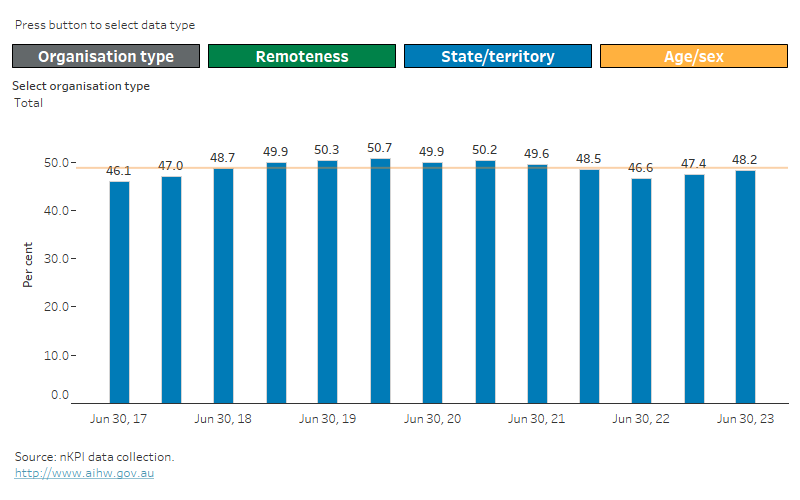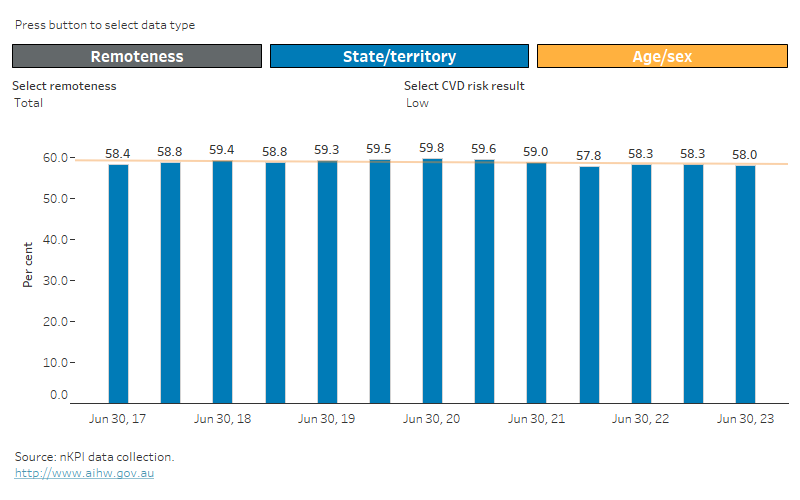Cardiovascular disease (CVD) risk assessment (PI20 and PI21)
Indicators related to cardiovascular disease (CVD) risk assessment in the national Key Performance Indicators (nKPI) collection are:
- CVD risk assessment (PI20): the proportion of First Nations regular clients aged 35–74 with no known history of CVD who had the necessary risk factors recorded within the previous 24 months to assess their absolute CVD risk
- CVD risk assessment result (PI21): the proportion of First Nations regular clients aged 35–74 with no known history of CVD who had an absolute CVD risk assessment result recorded within the previous 24 months as either:
- low – less than 10% chance of a cardiovascular event in the next 5 years
- medium – 10–15% chance of a cardiovascular event in the next 5 years
- high – greater than 15% chance of a cardiovascular event in the next 5 years.
PI20 and PI21 are collected for males and females in age groups:
- 35–44
- 45–54
- 55–64
- 65–74.
Why CVD risk assessment is important
Cardiovascular disease (CVD) includes a range of conditions that affect the heart and blood vessels. The most common and serious types of CVD include coronary heart disease, stroke and heart failure.
As a number of its risk factors are modifiable, CVD is preventable in many cases. Risk factors for CVD include overweight and obesity, tobacco smoking, high blood pressure, high blood cholesterol, insufficient physical activity, poor nutrition and diabetes.
Absolute CVD risk assessment combines risk factors to calculate the probability that an individual will develop a cardiovascular event or other vascular disease within a specified time frame (usually 5 years) (RACGP 2018).
Although age‐standardised CVD mortality for First Nations people has fallen over the past few decades, CVD remains the largest contributor to preventable morbidity and mortality in First Nations people (Agostino et. al. 2020, AIHW 2021).
Cardiovascular disease risk assessment (PI20)
At June 2023, 48% (or around 59,300) of First Nations regular clients aged 35–74 with no known history of CVD had the necessary risk factors recorded within the previous 24 months to assess their absolute CVD risk (Figure 1).
Figure 1: CVD risk assessment by reporting period
CVD risk assessment by reporting period
This Tableau visualisation shows the percentage of First Nations regular clients aged 35–74 with no known history of CVD who had information available to calculate their absolute CVD risk in the last 2 years for reporting periods from June 2017 to June 2023 for either:
- type of organisation (ACCHO, non-ACCHO)
- remoteness area (Major cities, Inner regional, Outer regional, Remote, Very remote)
- state/territory (NSW/ACT, Vic, Qld, WA, SA, Tas, NT)
- age/sex (male, female with age group 35–44, 45–54, 55–64, 65–74).
Data supporting this visualisation are available in Excel supplementary data tables at Data.

Note: For more information, including on interpreting changes over time, see Technical notes.
Cardiovascular disease risk assessment result (PI21)
At June 2023, 58% (or around 6,600) of First Nations regular clients aged 35–74 with no known history of CVD who had an absolute CVD risk recorded within the previous 24 months had a low absolute CVD risk, 7% (850) moderate and 35% (4,000) high (Figure 2).
Figure 2: CVD risk assessment result by reporting period
CVD risk assessment result by reporting period
This Tableau visualisation shows the percentage of First Nations regular clients aged 35–74 with no known history of CVD who had information available to calculate their absolute CVD risk in the last 2 years by CVD risk assessment result (low, medium, high), for reporting periods from June 2017 to June 2023 for either:
- remoteness area (Major cities, Inner regional, Outer regional, Remote, Very remote)
- state/territory (NSW/ACT, Vic, Qld, WA, SA, Tas, NT)
- age/sex (male, female with age group 35–44, 45–54, 55–64, 65–74).
Data supporting this visualisation are available in Excel supplementary data tables at Data.

Note: For more information, including on interpreting changes over time, see Technical notes.
For more information on cardiovascular disease risk assessment see Data.
References
Agostino J, Wong D, Paige E, Wade V, Connell C, Davey ME, Peiris DP, Fitzsimmons D, Burgess CP, Mahoney R, Lonsdale E, Fernando P, Malamoo L, Eades S, Brown A, Jennings G, Lovett RW and Banks E (2020) Cardiovascular disease risk assessment for Aboriginal and Torres Strait Islander adults aged under 35 years: a consensus statement. Medical Journal of Australia, 212(9):422–427, doi:10.5694/mja2.50529, accessed 1 November 2023.
AIHW (Australian Institute of Health and Welfare) (2021) Cardiovascular disease, Cat. no. CVD 83, AIHW, Australian Government, accessed 1 November 2023.
RACGP (The Royal Australian College of General Practitioners) (2018) Guidelines for preventive activities in general practice. 9th edition, updated, RACGP, accessed 1 November 2023.


